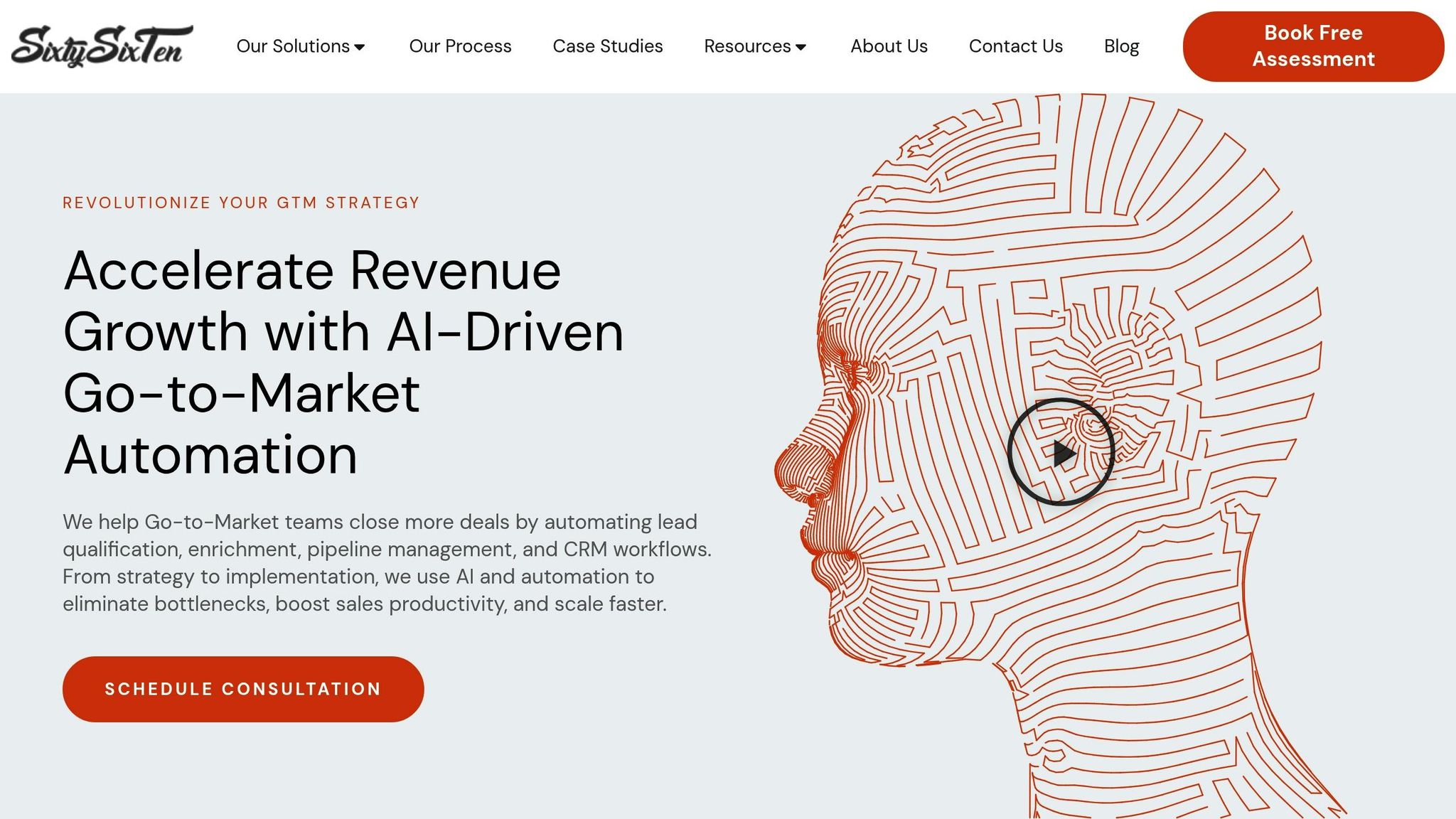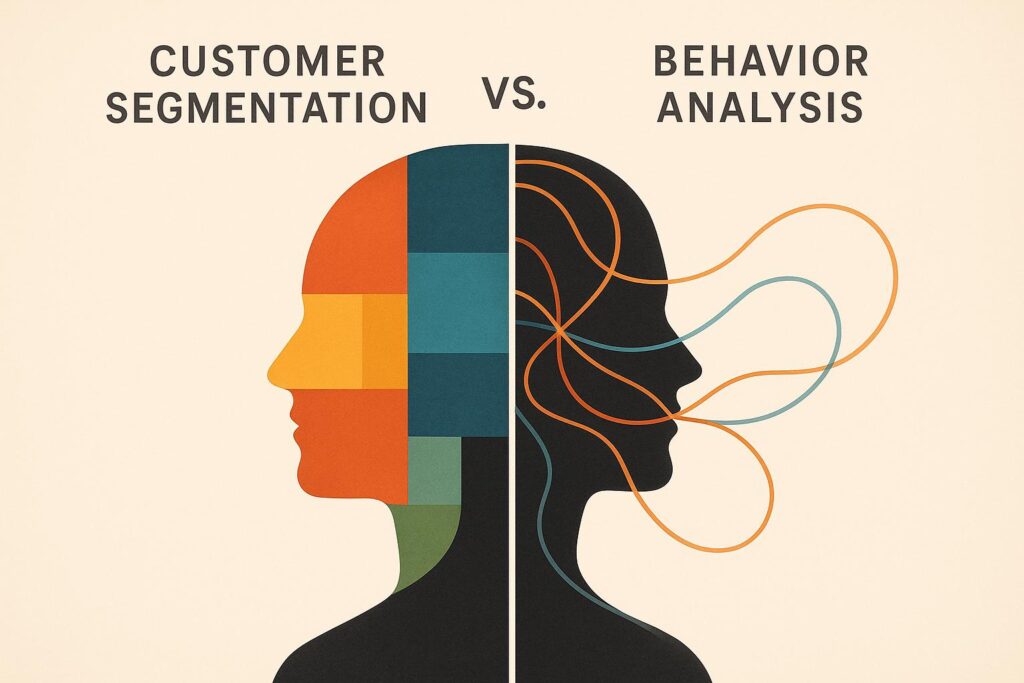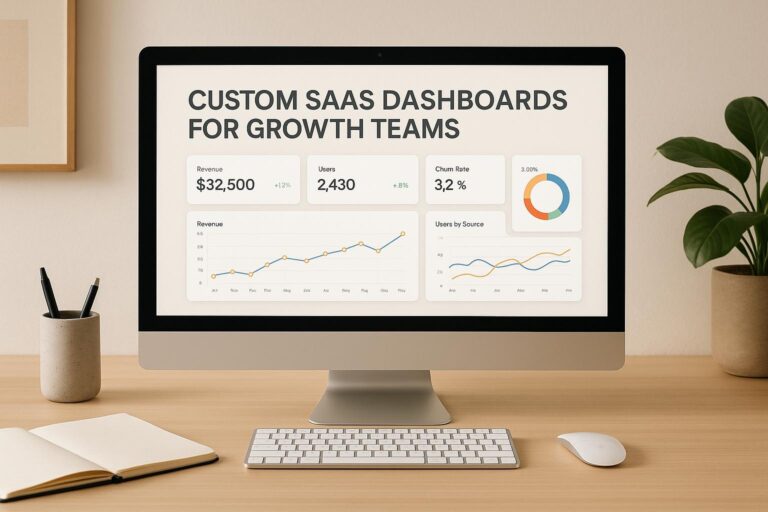Customer segmentation and behavior analysis are two key methods for understanding customers in B2B SaaS. Segmentation organizes customers into groups based on shared traits like industry or company size, helping with targeted marketing and product planning. Behavior analysis focuses on tracking real-time actions, such as feature usage or engagement trends, to predict future needs and personalize interactions.
Key Takeaways:
- Segmentation helps define "who" your customers are, using static traits like demographics or firmographics.
- Behavior analysis reveals "what" customers are doing, using dynamic data like clicks or feature usage patterns.
- When to use each:
- Use segmentation for strategic planning (e.g., market positioning, pricing, and campaign targeting).
- Use behavior analysis for real-time actions (e.g., lead scoring, upsell opportunities, and churn prevention).
- Combining both methods provides a complete view of customers, improving targeting and engagement.
Quick Comparison:
| Dimension | Customer Segmentation | Behavior Analysis |
|---|---|---|
| Focus | Groups customers by traits (e.g., industry, size) | Tracks actions and engagement patterns |
| Data Type | Static (e.g., demographics, firmographics) | Dynamic (e.g., clicks, usage, support tickets) |
| Update Frequency | Periodic (quarterly/annually) | Real-time or near real-time |
| Best Use Cases | Market planning, campaign targeting, pricing | Lead scoring, churn prevention, upselling |
| Scalability | Easier to implement, low maintenance | Requires advanced tools for real-time data |
Customer behavior analysis: what you NEED to know
What is Customer Segmentation?
Customer segmentation is all about grouping customers based on shared characteristics. Instead of treating every customer the same, this strategy helps B2B SaaS companies tailor their approach to meet the unique needs of each group.
By leveraging segmentation, businesses can fine-tune their product offerings, pricing strategies, and support systems. For example, a cybersecurity company might segment its customers by company size to address the differing security challenges of small businesses versus large enterprises. This insight influences how they market their product, set pricing tiers, and organize support services.
Segmentation also turns generic marketing into targeted, personalized campaigns. Imagine knowing that healthcare clients prioritize compliance features while fintech customers care more about integration capabilities. With this knowledge, you can create campaigns that speak directly to what matters most to each group.
Thanks to GTM (go-to-market) automation, segmentation can happen dynamically and in real-time. As data flows in from CRMs, product usage analytics, and marketing platforms, automated tools continuously refine customer groups and trigger workflows tailored to those segments.
Common Segmentation Models
B2B SaaS companies often rely on five key segmentation approaches to better understand customer behavior and preferences. These models are the backbone of GTM automation, ensuring customer profiles stay up-to-date and actionable.
- Demographic segmentation: This focuses on basic company details like industry, size, revenue, and location. For example, a project management software company might segment construction firms, marketing agencies, and software development teams separately.
- Firmographic segmentation: This digs into an organization’s structure and business model, including factors like funding stage, growth rate, and tech stack. A Series B SaaS company might segment startups, venture-backed scale-ups, and established enterprises differently.
- Psychographic segmentation: Here, the focus is on attitudes, values, and business priorities. Some companies may prioritize innovation and early adoption, while others lean toward reliable, proven solutions. Understanding these mindsets can guide messaging and product positioning.
- Behavioral segmentation: This groups customers based on their actions, such as how they use a product. For instance, you might identify power users who take advantage of advanced features, casual users who stick to basics, and dormant users who’ve reduced engagement.
- Needs-based segmentation: This approach centers on the problems customers are trying to solve or the outcomes they want. A CRM platform might segment users focused on lead generation, customer retention, sales automation, or analytics.
B2B SaaS Use Cases
Customer segmentation isn’t just theoretical – it drives practical improvements across every part of a company’s go-to-market strategy. Here’s how it translates into action:
- Campaign targeting: Instead of blasting generic messages to everyone, segmentation allows you to craft campaigns that directly address each group’s priorities.
- Resource allocation: Sales and customer success teams can focus their efforts on high-value segments while creating self-service tools for more budget-conscious groups.
- Product development: Segmentation reveals which features are most important to different customer groups, helping prioritize updates and roadmap decisions.
- Pricing strategy: Tailored pricing models can align with the budgets and needs of various segments, ensuring accessibility for some while maximizing revenue from others.
- Customer engagement: Personalized outreach, educational content, and onboarding flows can reduce the time it takes for customers to see value, boosting adoption rates.
- Lead scoring and qualification: By incorporating segment-specific behaviors and traits, you can ensure high-value leads get immediate attention, while others are guided through nurturing sequences.
Next, we’ll explore how analyzing customer behavior enhances these segmentation models.
What is Behavior Analysis?
Behavior analysis goes beyond basic segmentation, which groups customers by static traits like demographics or industry. Instead, it tracks real-time actions – like clicks, downloads, feature usage, or support interactions – to uncover how customers engage and transition from prospects to loyal users.
What makes behavior analysis so powerful is its ability to forecast future actions based on current patterns. For instance, if a customer starts exploring advanced features after sticking to basic ones, it could signal they’re ready for an upsell. On the flip side, a sudden drop in activity might flag a potential churn risk before the customer even begins considering alternatives.
Modern GTM (go-to-market) automation platforms take this a step further by processing these signals instantly and triggering personalized responses. As Make explains, “Make AI Agents open even more possibilities, with automation that thinks and acts in the moment”. Let’s dive into the data sources and methods that fuel this approach.
Data Sources and Methods
Behavior analysis pulls together data from a range of sources to create a detailed picture of customer actions. Here’s a breakdown of the key contributors:
- Product Analytics: Tracks every click, page view, and feature interaction, revealing patterns that surveys often miss.
- CRM Systems: Logs sales interactions, support tickets, and communication history to provide context on customer relationships.
- Email Marketing Tools: Monitors open rates, click-throughs, and engagement timing.
- Website Analytics: Tools like heat maps and form abandonment trackers highlight friction points during onboarding or sign-up.
- Social Media Monitoring: Captures brand mentions, competitor comparisons, and discussions that might signal buying intent.
At the heart of behavior analysis lies event tracking. Every meaningful action – whether it’s downloading a whitepaper or attending a webinar – is logged with timestamps, context, and user details. This timeline reveals preferences, pain points, and decision-making habits.
Advanced platforms also integrate enrichment services to add depth to these behavioral signals. For example, if a prospect repeatedly visits your pricing page, enrichment data might show they recently secured Series A funding, positioning them as a high-priority lead.
As Clay puts it, their platform lets teams "bring AI agents, enrichment, and intent data together and turn insights into relevant, timely action". In 2025, Adam Wall, Head of Sales Operations at Anthropic, used Clay to streamline lead enrichment and sales data pipelines by focusing on core tools like their CRM, Clay, and email platform.
GTM Automation Applications
Behavior analysis transforms raw customer data into actionable workflows, enabling businesses to respond intelligently and in real time. Here’s how it plays out:
- Lead Scoring and Churn Prediction: By analyzing usage patterns, support activity, and engagement dips, these systems can identify high-priority prospects and at-risk customers. Leads are automatically routed to sales, while retention workflows are triggered to re-engage users.
- Onboarding Optimization: Behavioral insights help pinpoint where new users struggle or drop off. Automated systems can then deliver just-in-time help content, schedule check-ins, or adjust onboarding flows based on individual progress.
- Upsell and Cross-Sell Opportunities: When customers approach plan limits or explore premium features, automated triggers can initiate upgrade conversations or deliver targeted messaging at the perfect moment.
In 2025, OpenAI’s Revenue Strategy & Data team, led by Scotty Huhn, used Clay to experiment with trigger-driven workflows and third-party enrichment data, achieving impressive results in GTM execution.
As Make describes, their real-time orchestration platforms provide “real-time visual orchestration for AI agents and automations,” allowing businesses to act on behavioral signals instantly.
The outcome? A GTM engine that feels personal and responsive while operating at scale. Behavioral triggers ensure that every message is timely, relevant, and perfectly aligned with the customer’s journey.
sbb-itb-647c22e
Customer Segmentation vs Behavior Analysis
Customer segmentation focuses on grouping customers based on shared characteristics, while behavior analysis tracks ongoing customer actions to understand their real-time interactions.
Side-by-Side Comparison
Here’s a closer look at how these two approaches differ across key business dimensions:
| Dimension | Customer Segmentation | Behavior Analysis |
|---|---|---|
| Primary Focus | Groups customers by common traits (e.g., demographics, firmographics, psychographics) | Monitors individual actions and usage patterns over time |
| Data Requirements | Relies on static attributes like company size, industry, role, or location | Uses dynamic data like clicks, feature usage, support tickets, and engagement timing |
| Update Frequency | Typically reviewed quarterly or annually; segments stay relatively stable | Updates in real-time or near real-time as patterns evolve |
| Business Applications | Best for market positioning, campaign targeting, and product planning | Ideal for lead scoring, churn reduction, personalized messaging, and upsell triggers |
| Scalability | Highly scalable with minimal upkeep once segments are defined | Requires advanced data infrastructure for real-time processing |
| Predictive Power | Limited to identifying broad trends within segments | Strong for predicting individual customer actions |
The table highlights how segmentation and behavior analysis serve different purposes. Segmentation is ideal for strategic planning, such as identifying broad customer categories like "Enterprise", "Mid-Market", and "SMB." For instance, a B2B SaaS company might use these categories to craft tailored pricing models and marketing campaigns. These segments typically remain stable over time.
On the other hand, behavior analysis shines in tactical execution. For example, if a mid-market prospect downloads several whitepapers, revisits the pricing page, and requests a demo, behavior analysis can trigger an automated workflow to assign the lead to a senior sales rep.
How They Work Together
Combining segmentation and behavior analysis creates a more effective go-to-market (GTM) strategy. Segmentation lays the groundwork by identifying the "who", while behavior analysis adds the "when" through actionable insights.
Take a SaaS company targeting "Growing Startups" as an example. Segmentation might reveal that this group converts best when users hit specific usage milestones within their first 30 days. Behavior analysis can then track those milestones, ensuring timely engagement. For instance, instead of sending generic emails to the entire segment, automation can deliver personalized messages based on actual user behavior. A startup founder actively using collaboration tools might receive content about improving team productivity, while another exploring reporting features might get insights on data-driven decision-making.
This integration also creates a feedback loop that continuously refines both methods. Behavioral data can uncover new segmentation opportunities, such as identifying unique patterns among startups in different industries. Similarly, analyzing segment performance can highlight the most effective behavioral triggers for various customer types.
Modern GTM automation platforms are designed to seamlessly combine these methods. They manage segment-based rules while processing thousands of behavioral signals in real-time, ensuring every interaction feels relevant and perfectly timed to the customer’s journey.
When to Use Each Approach
Choosing the Right Method
Deciding between segmentation and behavior analysis depends on your business goals and the maturity of your go-to-market (GTM) strategy. Each method shines in different scenarios, and knowing when to use one – or both – can significantly enhance your outcomes.
Customer segmentation works best when building the foundation of your GTM strategy. For instance, if you’re defining your Ideal Customer Profile (ICP) or calculating your Total Addressable Market (TAM), segmentation provides the framework you need. It’s also critical for product launches and entering new markets, helping you identify and focus on the right customer groups. In sales territory planning, segmentation allows teams to divide markets using demographic and firmographic data, ensuring each representative is assigned accounts that suit their expertise.
Segmentation also plays a key role in Account-Based Marketing (ABM). By combining enrichment data, CRM records, and other signals, you can create dynamic, high-intent buyer segments. These segments are essential for delivering personalized marketing campaigns that resonate with your audience.
On the other hand, behavior analysis is indispensable when real-time insights are required. For example, you can use behavioral data to improve lead scoring, identifying prospects who are ready to convert – such as those repeatedly visiting pricing pages, engaging with case studies, or requesting demos – and trigger immediate sales outreach. Behavior analysis is also valuable for preventing churn. If user engagement drops or support requests spike, behavioral triggers can launch retention campaigns automatically. Additionally, tracking user flows can uncover friction points that segmentation might overlook, helping you refine product features and improve onboarding processes.
The complexity of your data often dictates which approach to prioritize. Segmentation typically requires less technical effort and can be implemented using basic CRM tools. In contrast, behavior analysis demands real-time data integration and more advanced processing capabilities.
By understanding these distinctions, you can lay the groundwork for a strategy that blends both methods seamlessly.
Integrated Solutions with SixtySixTen

Modern GTM automation systems make it possible to combine segmentation and behavior analysis without compromise. SixtySixTen offers engineering-driven solutions that integrate both approaches using platforms like n8n, Zapier, Make.com, and Clay.com to create robust customer intelligence systems.
These systems start with AI agents that merge segmentation criteria with behavioral signals for lead scoring. For instance, they can identify a prospect as part of your "Enterprise SaaS" segment while simultaneously tracking their recent actions – like downloading a whitepaper or visiting your pricing page. This dual-layered insight provides a more complete understanding of the customer.
When off-the-shelf tools can’t handle the complexity of integrating multiple data sources in real time, custom-coded solutions step in. SixtySixTen designs tailored systems that pull segmentation data from CRMs while processing behavioral events from websites, product analytics, and email platforms. The result is continuously updated customer profiles that combine both static and dynamic insights.
Automated workflows further simplify the process of acting on these insights. For example, if a prospect in your "High-Value SMB" segment demonstrates specific engagement behaviors, automated systems can send personalized email sequences, assign the lead to a specialized sales rep, and update CRM records – all without manual intervention.
Dashboards and reporting tools, built with platforms like Google Looker and PowerBI, provide visibility into these efforts. Sales teams can track which segments are converting most effectively while monitoring real-time behavioral trends that may signal changes in the market.
For teams looking to experiment, no-code/low-code platforms like Trigify allow for quick testing and iteration of segmentation and behavioral rules. This flexibility empowers marketing teams to refine audience definitions or triggers without needing extensive development resources.
These integrated systems create a powerful feedback loop: behavioral data can highlight new segmentation opportunities, while analyzing segment performance can reveal the most effective behavioral triggers for specific customer types. This continuous cycle of optimization ensures your GTM strategy evolves alongside your market and customer base, combining the strategic insights of segmentation with the precision of behavior analysis to enhance engagement throughout the buyer’s journey.
Conclusion
Customer segmentation and behavior analysis work hand-in-hand as vital tools for successful B2B SaaS go-to-market (GTM) strategies. While segmentation organizes customers into groups based on demographics and firmographics, behavior analysis provides real-time insights into how customers act and what signals they’re sending about their intentions.
When these two approaches are combined, GTM teams can shift from broad, generalized targeting to highly specific, intent-driven engagement with qualified prospects. This shift not only sharpens customer targeting but also makes GTM execution more efficient and impactful.
Modern platforms make it easier to integrate these methods, enhancing both the precision of targeting and the quality of engagement. For instance, OpenAI significantly improved its data enrichment efforts by using Clay, boosting enrichment coverage from the low 40% range to the high 80% range. This improved data completeness allows for more accurate segmentation and provides deeper behavioral insights for analysis.
The power of combining firmographic segmentation with behavioral triggers lies in its ability to fuel automated, real-time workflows. Marketing efforts become more personalized, sales teams can focus on higher-quality leads, and customer success teams can proactively mitigate churn risks before they escalate.
For B2B SaaS companies that have moved past the product-market fit stage, the choice isn’t between segmentation and behavior analysis – it’s about seamlessly integrating both. Those who succeed in this integration gain a clear edge: more efficient GTM operations, better conversion rates, and stronger relationships with customers built on actionable, data-driven insights rather than guesswork.
This integration remains a standout factor for revenue teams aiming to excel as GTM strategies continue to evolve.
FAQs
What’s the best way for B2B SaaS companies to combine customer segmentation and behavior analysis to improve their go-to-market strategies?
B2B SaaS companies can supercharge their go-to-market (GTM) strategies by weaving customer segmentation and behavior analysis into their operations. Customer segmentation breaks down your audience into distinct groups, while behavior analysis digs into how these groups interact with your product or service. When combined, these tools allow for sharper targeting and more tailored engagement.
To simplify this process, automation tools and AI-driven systems can handle tasks like lead scoring, email campaigns, and CRM updates. Automating these workflows frees up your team to concentrate on high-value activities, such as closing deals and refining outreach strategies. This approach not only boosts efficiency but also ensures decisions are rooted in data, paving the way for sustainable growth.
What are the pros and cons of using real-time data for behavior analysis versus static data for customer segmentation?
Real-time data in behavior analysis gives businesses the power to understand customer actions as they unfold. This means they can respond quickly and create interactions tailored to individual needs in the moment. However, handling the sheer volume and speed of this data can be a tough challenge.
In contrast, customer segmentation relies on static data – information that doesn’t change as frequently. This makes it easier to manage and provides a reliable way to group customers based on shared traits. While it may not offer the same immediacy, it’s incredibly useful for shaping long-term strategies and plans. By integrating automation and AI, businesses can simplify these processes, striking a balance between real-time adaptability and the strategic advantages of segmentation.
When should a company focus on behavior analysis instead of customer segmentation, and vice versa?
Customer segmentation and behavior analysis play distinct roles depending on what your business needs. Customer segmentation helps you categorize your audience into groups based on shared traits like demographics, geographic location, or buying behavior. This makes it easier to create targeted marketing campaigns and develop products that resonate with specific groups.
Meanwhile, behavior analysis digs deeper into how customers engage with your product or service. It looks at things like browsing habits, what motivates purchases, or how often they interact with your brand. This method is particularly useful when you’re looking to enhance user experience, boost customer loyalty, or spot opportunities to upsell.
In short, segmentation is your go-to for big-picture planning and broad audience targeting, while behavior analysis is all about fine-tuning interactions and delivering a more personalized customer experience.



